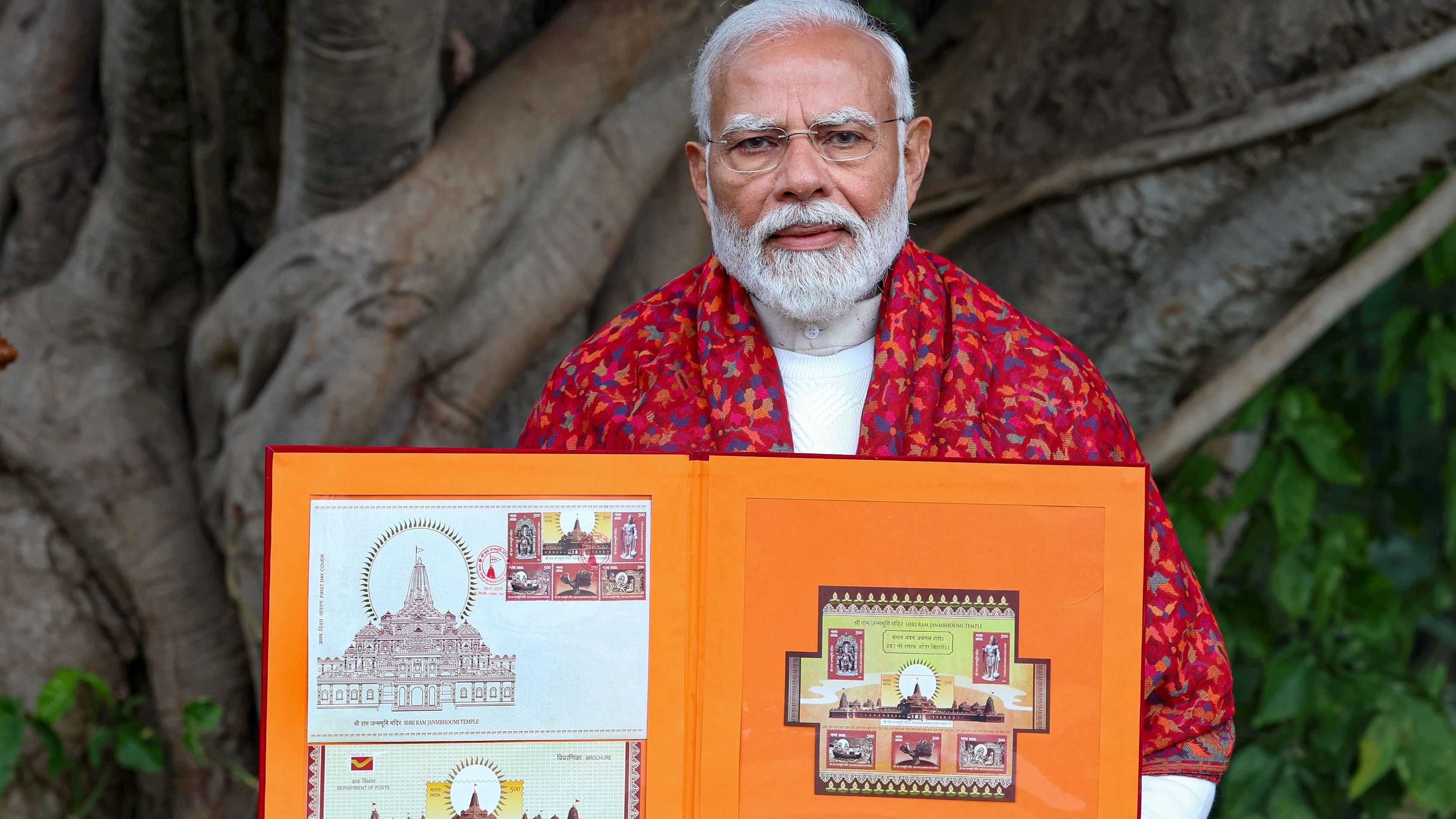
Prime Minister Narendra Modi releases commemorative postage stamps on Shri Ram Janmabhoomi Temple and a book of stamps issued on Lord Ram around the world, in New Delhi, Thursday, January 18, 2024.
Credit: PTI Photo
Bengaluru: Bengaluru-based Sushil Mehra who has been a collector of stamps for nearly 50 years now says yesterday was a good day for philatelists. To mark the Ram temple consecration, Prime Minister Narendra Modi had released a series of commemorative postage stamps as well as a book featuring Ram stamps from around the world.
The book, released on Thursday, will be good research material, says Mehra.
"For 20 years, I have been collecting philatelic material as well as trade cards and match boxes pertaining to Hindu mythology and Dashavatar, particularly Ram and Krishna,” says Mehra, whose firm sells furniture to schools and offices.
Initially, Mehra says, he was more focused on Krishna, as he is a big devotee of Krishna. “I am from Delhi, I moved to Bengaluru only in 1978. Krishna plays a big role in my childhood memories. My father often used to take me to Mathura and to many Raslila performances,” adds Mehra.
But when he came across a colourful set of lithographed trade cards featuring scenes from the famous Ramayana ballet of Indonesia, issued by Liebig Fleisch Extract, a company formed in 1865 in London to produce a cheaper substitute for real meat, Mehra decided to expand his Ram collection.
“It may be categorised under non-philatelic supplemental material, like match box labels and cigarette cards, but it is a popular collectible. Liebig had published more than 11,000 cards, in sets of 12 and six, featuring interesting stories from around the world,” says Mehra.
The reverse of the cards that came along with the products until 1975 usually contained advertising for other Liebig products or had a recipe for meat extracts. The ones with him, says Mehra, contain the prices of various Liebig products.
Although there are only about 40 stamps issued in India from 1951 onwards that directly pertain to Ram— and about 40 from outside India—Mehra says it is possible to develop Ram as a theme in a three-frame exhibit with the use of supplementary materials as well as by linking with other themes.
For instance, in Mehra’s collection there is a first-day cover (FDC) issued in Jakarta to commemorate the year of the monkey in the Chinese calendar. But the monkey character featured in the FDC has its 'tail on fire', as Hanuman is also famous in Indonesia.
"So, it may be a cover directly for Chinese New Year, but it indirectly tells a story in my Ram collection— that of Ram’s popularity in Indonesia," says Mehra.
Mehra also has a postage stamp of three-and-half annas value, issued on January 26, 1950, featuring Mahatma Gandhi’s favourite anthem, ‘Raghupati Raghava Raja Ram’. He has categorised this in his ‘Ram’ collection. “For one, it is also called Ram Dhun. The lyrics I think are inspired from ‘Shri Nama Ramayanam’ written by Lakshmanacharya,” says Mehra.
His Ram collection also includes a page from the Constitution of India, as the original calligraphed copy of the Constitution contained a scene from Ramayana— of Lord Rama returning to Ayodhya along with Sita and Lakshman after defeating Ravana.
One other way he augmented his collection is by sending himself mails with self-designed envelopes, says Mehra, pointing to the two envelopes, one with a 3D-rendered image of Ayodhya Ram Mandir along with a Rs 10 donation receipt and one with a generic image of a gavel, alluding to the Supreme Court’s verdict on the Ayodhya dispute, for example.
“When they were on the news, I printed them on a white envelope, used a stamp from the Ramayana series, and sent it to myself,” says Mehra.
Mehra says this was something he did every day during Covid— find something that was worth recording, get a representative image and print that on an envelope and send himself mails (which he promptly exhibited at the South India Philatelists’ Association’s Coverpex 2020 as ‘Every Cover Tells A Story’ and won the Vermeil award for numismatics).
But the serious collector in him also hankers after all things old and spends a considerable amount of money in acquiring them, he says. “So far, I have spent Rs 5 lakh on my Dashavatar collection alone,” he adds.
One of the valuable items in his collection is a telegram receipt from the then Bombay distributor to then then Bangalore distributor informing him about the special screening of the 1961 film, Sampoorna Ramayana directed by Babubhai Mistry.
Mehra says he also has an interesting collection of British India Bazar postcards on Lord Rama. “Bazar postcards were printed by local presses and were often colourful. They featured famous kings, Ravi Varma’s oleographs, gods, goddesses, birds, flowers… Although they were not on sale in post offices, and can be purchased outside (bazars), they were intended to be used as postal stationery after affixing stamps of appropriate value, and are valid philatelic material,” says Mehra.
The philatelist’s most favourite item in his Ram collection is a rare 1902 British India postcard cancelled from Faizabad (part of Ayodhya district now). “It is valuable, yes. But I hold it dear because it was cancelled on August 23, my wedding anniversary. It is little connections like these that make philately worth every effort and penny,” he adds.